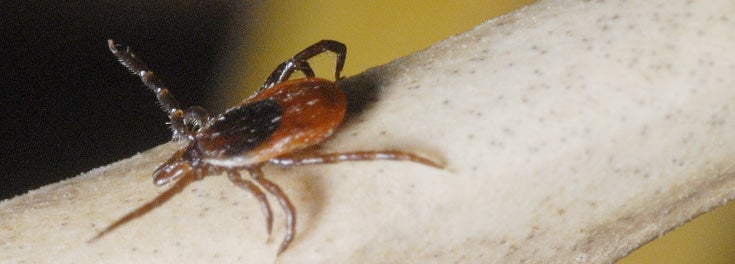
You’ve heard of heat and air quality indexes, pollen counts, and severe weather warnings. Now there’s a tick activity index that can tell you your risk of encountering disease-carrying ticks in different parts of the country. It’s an interactive website application that includes pictures of the kinds of ticks most likely to be biting, and it’s the product of URI entomologist Tom Mather and the students and researchers who work with him at URI’s Center for Vector-borne Disease.
The URI Center for Vector-borne Diesease has become a national leader in the study and prevention of Lyme and other arthropod-associated diseases that threaten humans and animals.
The Center — where faculty and students work together to improve diagnostic tools, develop prevention and control measures, and build community-based partnerships — has become a national leader in the study and prevention of Lyme and other arthropod-associated diseases that threaten humans and animals.
For example, Pharmacy Professor Roberta King thinks she’s identified a way to interfere with tick salivation, which in turn could prevent ticks from feeding. If they don’t feed for at least 24 hours, they also don’t transmit diseases. Professor King has been working with Professor Mather since 2006, first on a vaccine or drug that targets a certain component in tick saliva, and now they’re targeting tick saliva with a topical drug in a cream or lotion that people could apply.
Entomology Professor Roger LeBrun, who’s been studying diseases transmitted by ticks and mosquitoes for more than 30 years, says he and his colleagues are exploring a number of hypotheses to explain why Lyme disease is rare in southern tick populations and common in the northeast, which could help develop better prevention strategies.
Mather’s TickEncounter Resource Center is working on prevention by way of engaging the public. “People know what they should do to prevent getting bitten, but they just don’t do it,” Mather said. So he’s working to make tick bite prevention easier, more fun, and interactive.
For starters, he’s developing a tick encounter risk calculator – a smart-phone application that allows assesses tick risk level based on factors like habitat, pets, geography, and any control steps being taken, and produces a customized tick-bite protection action plan. His TickEncounter website is rapidly becoming one of the nation’s premier tick bite protection resources, with a growing catalog of such tools as an interactive tick identification chart, shower cards for prompting daily tick checks, tick encounter risk maps, and other strategies for protecting yourself, your pets, and your yard from ticks. And, he’s collaborated with a number of clothing companies to design and production of clothing pre-treated with repellent containing Permetrin, found to be the best option for preventing tick bites.
“This new strategy is a paradigm shift for most people, but it’s also the best thing you can do to protect against the many diseases that ticks transmit.”
Ticks are pretty small, but their bite is big. And at URI, you can help work all the angles to take the disease out of that bite.
